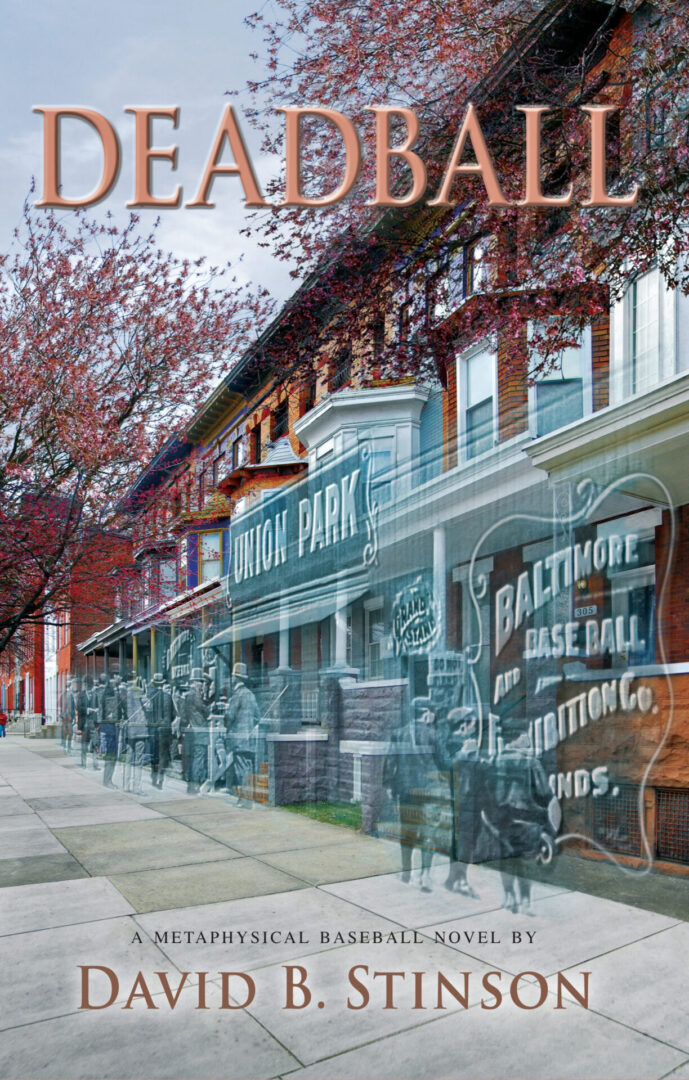Plant Field was located near the northeast intersection of North Boulevard and West North B Street in Tampa, Florida. Constructed in the 1890s, the athletic facility was on the grounds of the Tampa Bay Hotel and included a variety of athletic fields, including horse racing, for guests of the hotel. Plant Field was named after Henry Plant, the owner of the hotel. After his death in 1899, the hotel and accompanying grounds, including Plant Field, were purchased by the City of Tampa. In 1933, the city leased the Tampa Bay Hotel to what is now the University of Tampa. The University also was allowed to use Plant Field for school athletic events.
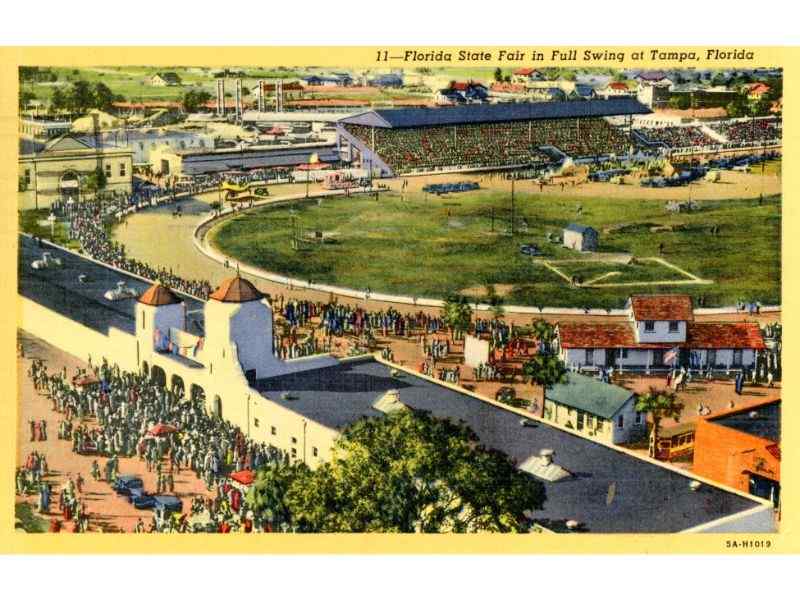
Plant Field was one of the first sites to host Spring Training in Florida (Jacksonville, Florida, lays claim to the first major league spring training site in Florida, first in 1888 and then in 1903, while St. Augustine hosted spring training in 1890 at Flagler Grounds). In 1913, Tampa Mayor D.B. McKay convinced the Chicago Cubs to train at Plant Field by actually paying the team to play in Tampa. The following season, St. Petersburg businessman Al Lang likewise convinced the St. Louis Browns to train nearby at Sunshine Park (also known as Coffee Pot Park), and the Grapefruit League was born. The Cubs trained at Plant Field through the 1916 season.
In 1919 the Boston Red Sox trained for one season at Plant Field. That spring season was memorable if for no other reason thanon April 4, 1919, then-Boston Red Sox player Babe Ruth hit what is considered to be his longest home run – a 587 feet blast (albeit in an exhibition game).
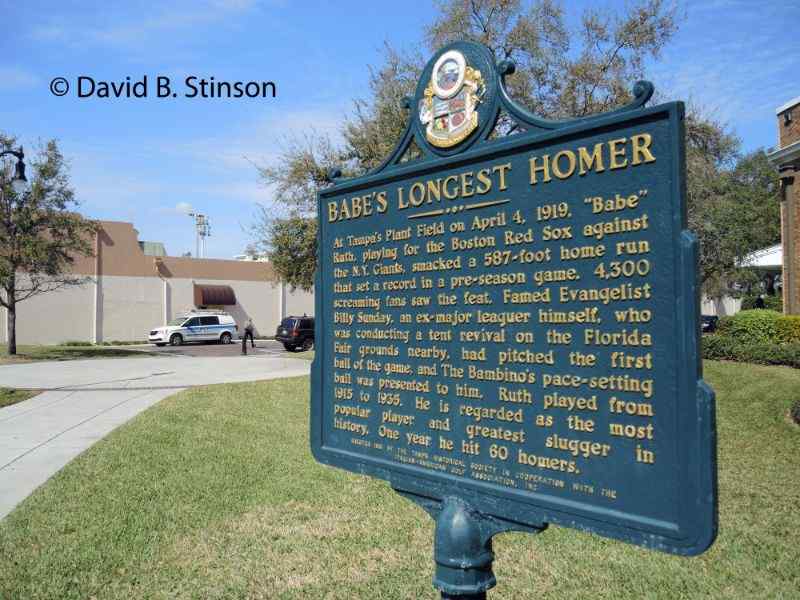
The ball cleared Plant Field and came to rest in an open space near what is now the John Skyes College of Business, which formerly was the City of Tampa Municipal Auditorium, constructed six years after Babe Ruth hit his mammoth shot. A historic plaque on the University of Tampa campus marks the approximate spot where the ball was found.
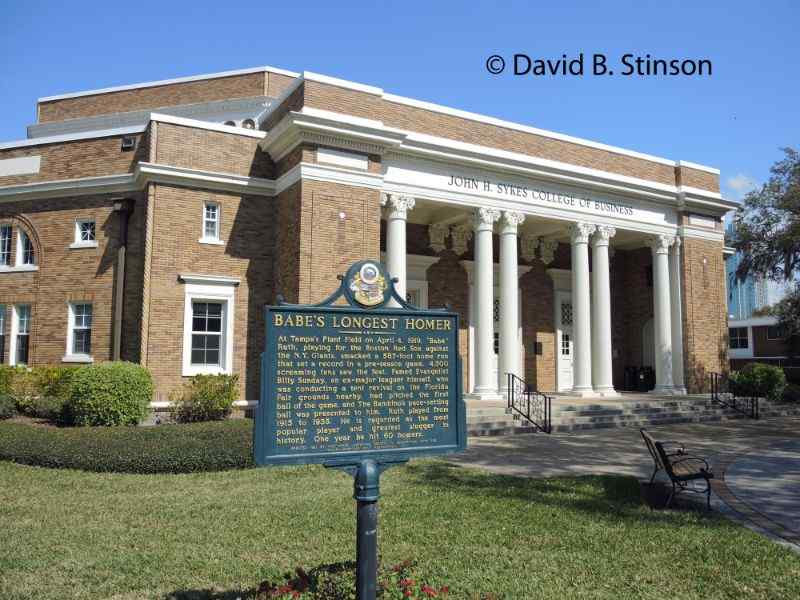
According to local newspaper accounts, the ball rolled a considerable distance once it landed. New York Giants Manager John McGraw (his team was playing the Red Sox) is said to have chased down the ball, calling the home run the longest he had ever seen. McGraw presented the ball to the Reverend Billy Sunday, a former ballplayer who was in town for a Christian revival and had thrown out the first pitch that afternoon.

From 1920 to 1929, the Washington Senators trained at Plant Field. The Detroit Tigers trained at Plant Field for one season, in 1930, and the Cincinnati Reds trained at Plant Field from 1931 to 1942 and 1946 to 1954. Beginning in 1955, the Reds continued to train at Plant Field, but played home exhibition games at Al Lopez Field. The Chicago White Sox also trained at Plant Field for just one season in 1954, before relocating their spring training four miles northeast to Al Lopez Field in 1955. The Reds took over sole occupancy of Al Lopez Field in 1960 when the White Sox moved to a refurbished Payne Park in Sarasota, Florida.

For much of its existence, Plant Field was co-located on the Florida State Fairgrounds, surrounded by a horse and automobile race track. Plant Field encompassed a significant portion of the southern half of the fairgrounds.
The Florida State League Tampa Smokers played their home games at Plant Field from 1919-1927. In 1928, the Smokers changed their name to the Tampa Krewes, still playing their home games at Plant Field. The Smokers changed their league affiliation to the Southeastern League in 1929, and played at Plant Field until the end of the 1930 season. In 1946, the Smokers returned to Plant Field as an affiliate of the Florida International League, playing their home games at Plant Field through the 1954 season.
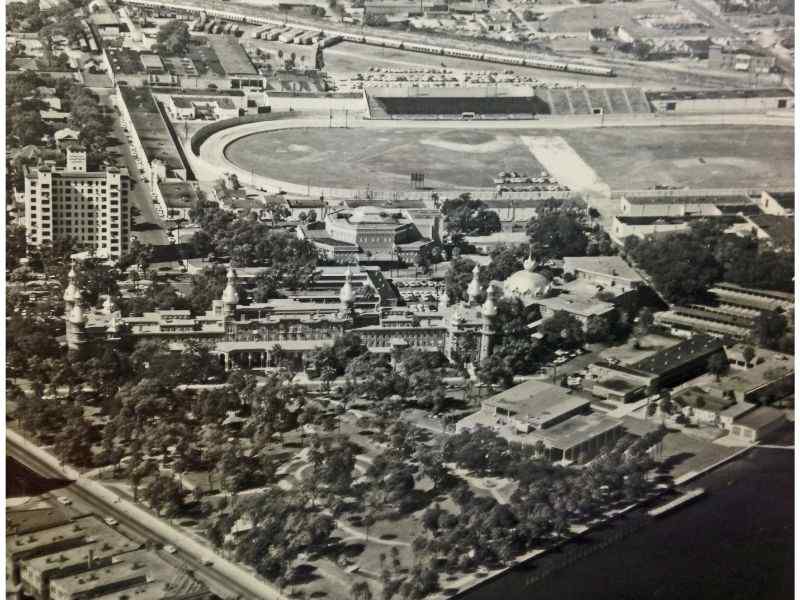
By 1960, professional baseball had departed Plant Field. Over the years Plant Field was reconfigured for soccer and baseball for use by the University of Tampa. In 1971, the University of Tampa acquired ownership of Plant Field and the facility was renamed Pepin/Rood Stadium. In 2002 the grandstand constructed in the early 1920s was raised.
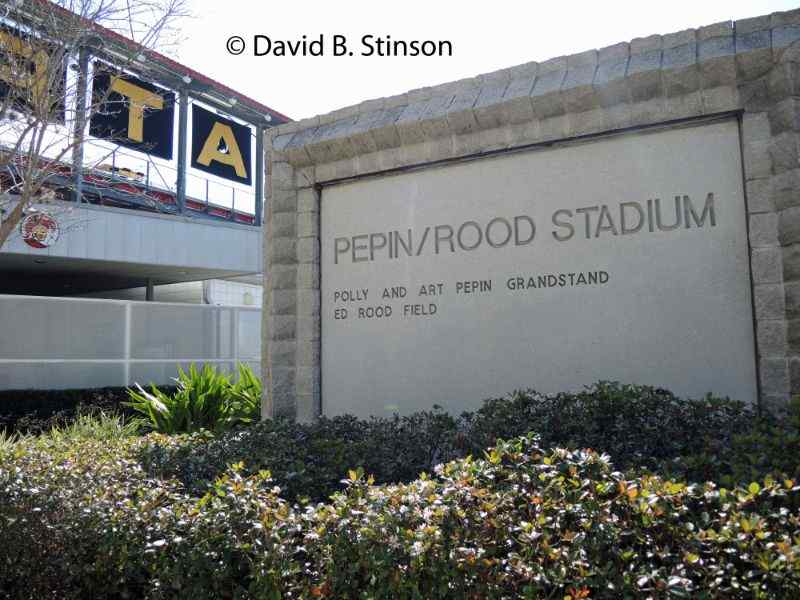
A new grandstand was installed in approximately the same spot as the original grandstand (the new grandstand is not as close to North Boulevard and is centered a few yards south of the original grandstand). Straz Hall, a residence hall for the University, is located on the site of the uncovered bleachers which were once attached just to the north of the covered grandstand.
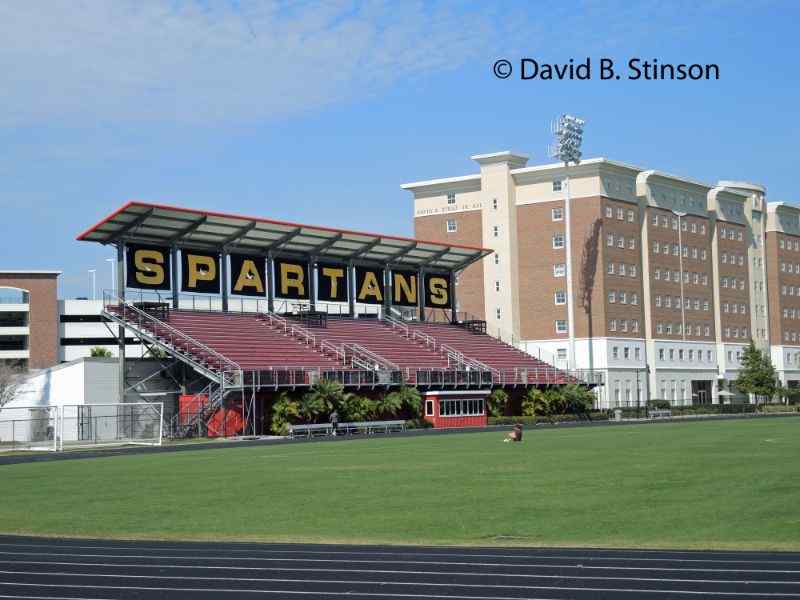
The actual infield may be long gone, but the field is still used for athletic events.

Home plate was located just a few feet east of the current running track that parallels the grandstand. The current running track also cuts through center field on the opposite end of the track. A row of one-story buildings remain at the site today. The deepest part of center field once edged close to those buildings, separated by the original fair grounds race track.
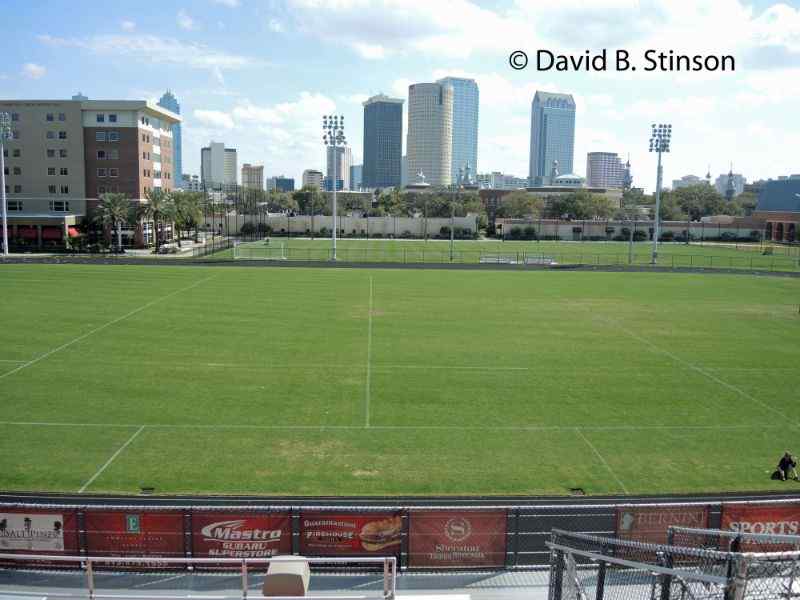
The first and third base foul lines ran at 45 degree angles away from home plate, as seen in the photograph below.
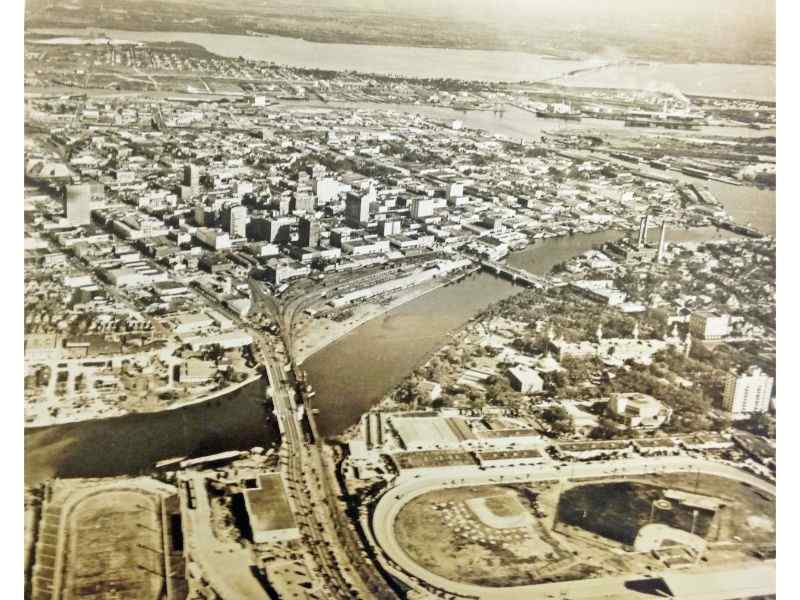
Today the left and right field lines are part of the soccer field. Out beyond the former site of left field is Frank and Carol Morsani Hall
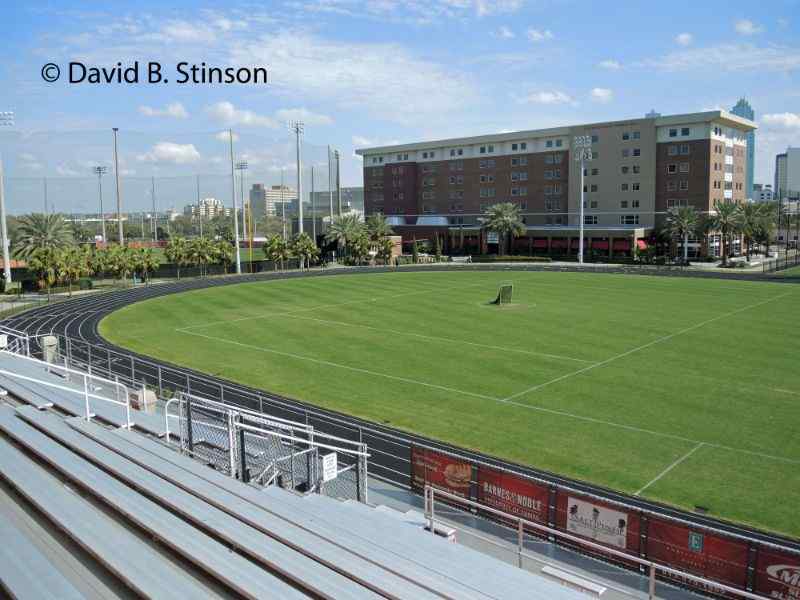
Sykes Chapel sits beyond the former site of right field.
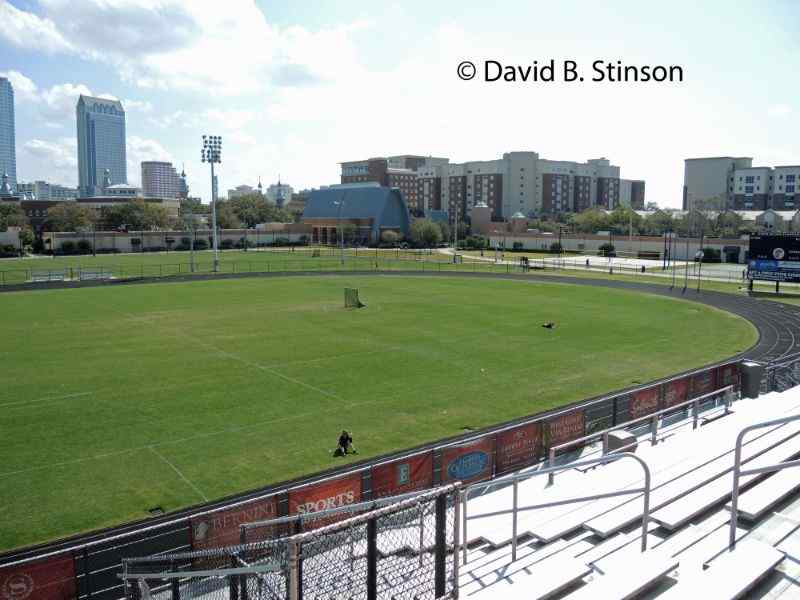
A Hillsborough County historical plaque marks the former location of Plant Field.

The plaque summarizes the many athletic events that took place at Plant Field, including football and auto racing.
It states, in part: “The area encompassing the University of Tampa’s baseball, track, and soccer facilities was known as Plant Field from early in the 20th century until the mid-1970s. Plant Field, named for railroad and hotel magnate Henry B. Plant, served as the site for significant sporting events and other community activies. The one-half mile horse racing track that Plant built in the late 1890s was altered to accommodate dirt-track auto racing. From February 1921 until the mid-1970s, races were held each year during the South Florida Fair, later designated as the Florida State Fair. Along with talented local racers, the country’s most famous drivers, including Jimmy Wilburn, Emory Collins, Gus Schrader, Ted Horn, Frank Luptow, Tommy Hinnershitz, and Bobby Grimm raced here during the winter months. Pete Folse, a local driver, became a national champion. Their cars were powered by engines made by Miller, Offenhauser, and Riley, among others. Tampa became known as “The winter auto racing capital of the nation.” Sadly, several drivers lost their lives at Plant Field. Plant Field was also the site for football games. On New Year’s Day 1926, the Chicago Bears, starring Red Grange, defeated a team featuring Jim Thorpe. The University of Tampa played its home games on Plant Field from 1933 to 1936. Tampa high school teams also competed on Plant Field. Plant Field served as the home for several major league baseball teams during spring training. The Chicago Cubs arrived in 1913 and returned each year through 1916. The Boston Red Sox played their home games at Plant Field in 1919, and Babe Ruth, playing for teh Red Sox, hit the longest home run of his career during a game on this field. Plant Field was home for the Washington Senators during the 1920s, for the Detroit Tigers in 1930 and for the Chicago White Sox in 1954. The Cincinnati Reds played here for most seasons starting in the 1930s through 1954. In November 1950, an African American all-star team, led by Jackie Robinson, played an exhibition game against the Tampa Rockets, a semi-professional African-American team. In the minor leagues. the Tampa Smokers played their home games at Plant Field.”
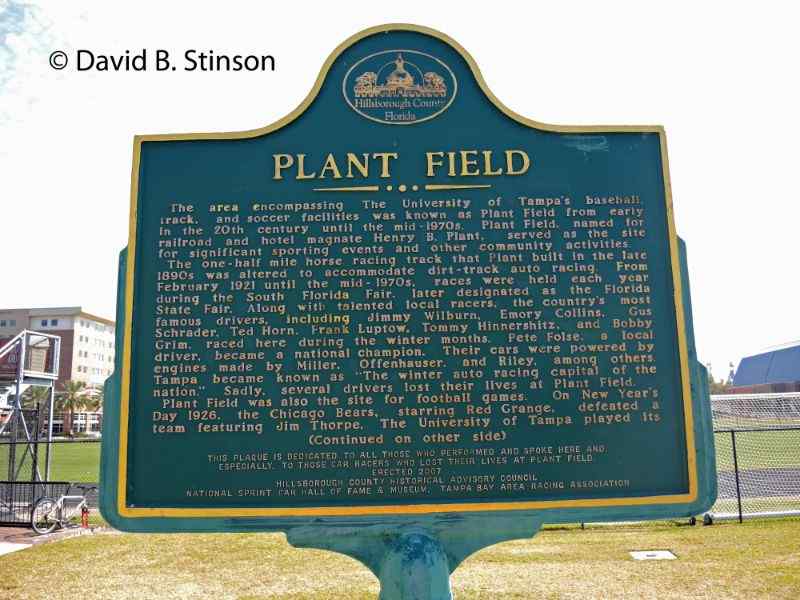
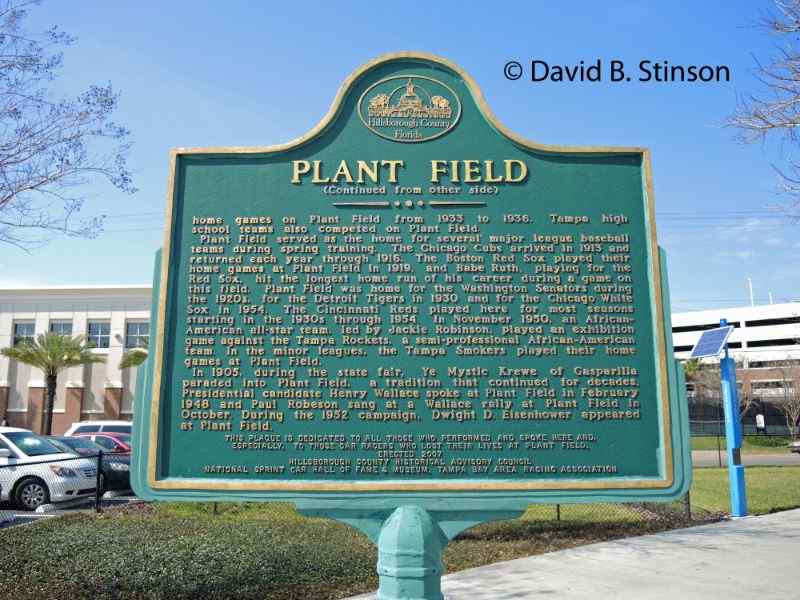
The front entrance to Pepin Stadium is accessible from North Boulevard, just south of Straz Hall on the University of Tampa campus.

Pepin Stadium includes a modest concession stand built where once sat team administrative offices.
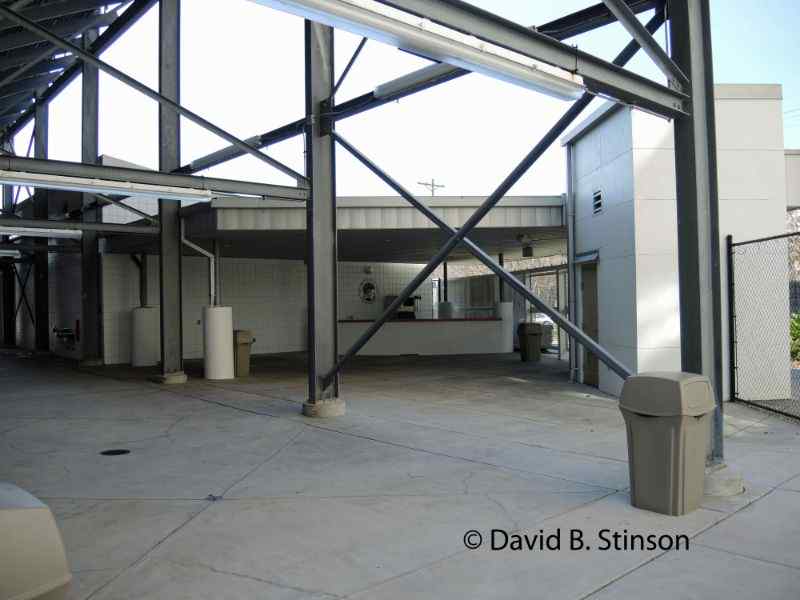
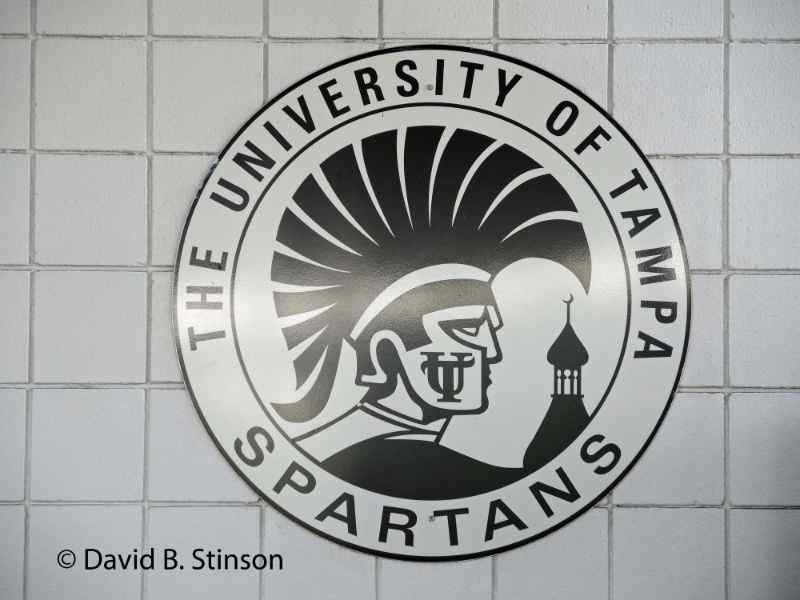
A curious remnant of Plant Field remains inside Pepin Stadium, namely two antiquated turnstiles, one stored under a stairway and one near the grandstand entrance, although it does not appear that either are currently in use.
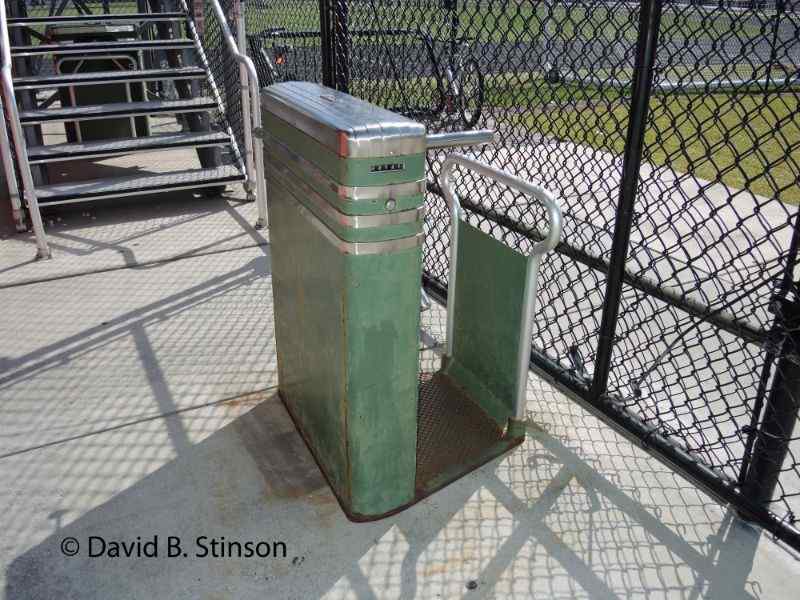
Just north of Pepin Stadium and the former site of Plant Field, is the University of Tampa Baseball Field, also known as Sam Bailey Field.
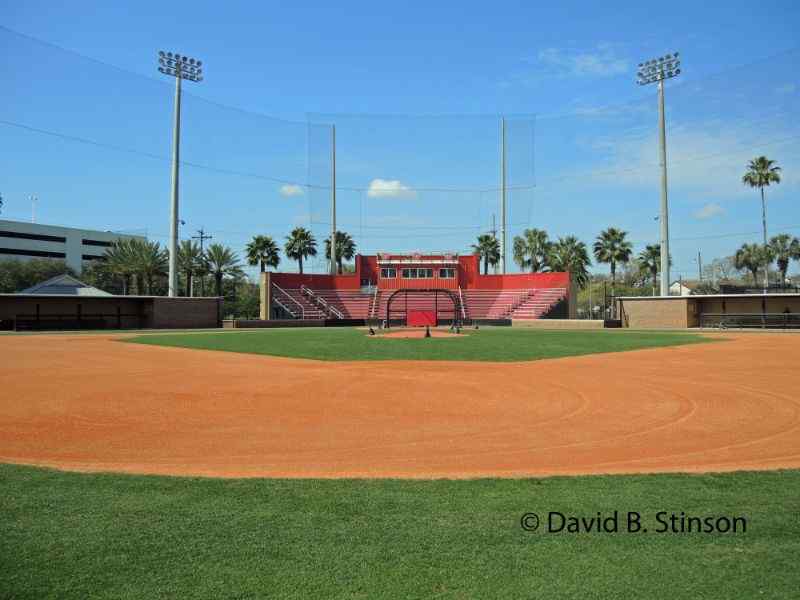
The light stanchions of Pepin Stadium are visible from the university’s baseball field.
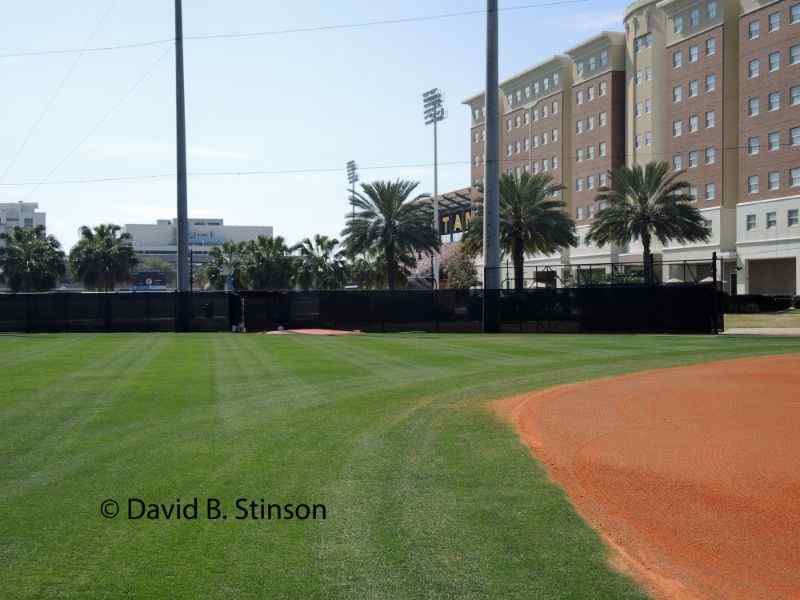
The baseball field sits within the northern end of the old Florida Fair Grounds. Just north of the baseball field, across West Cass Street, is the former location of Phillips Field (now the site of Tampa Preparatory School). Phillips Field was the long-time home of the University of Tampa football team, as well as the location for several NFL preseason games.
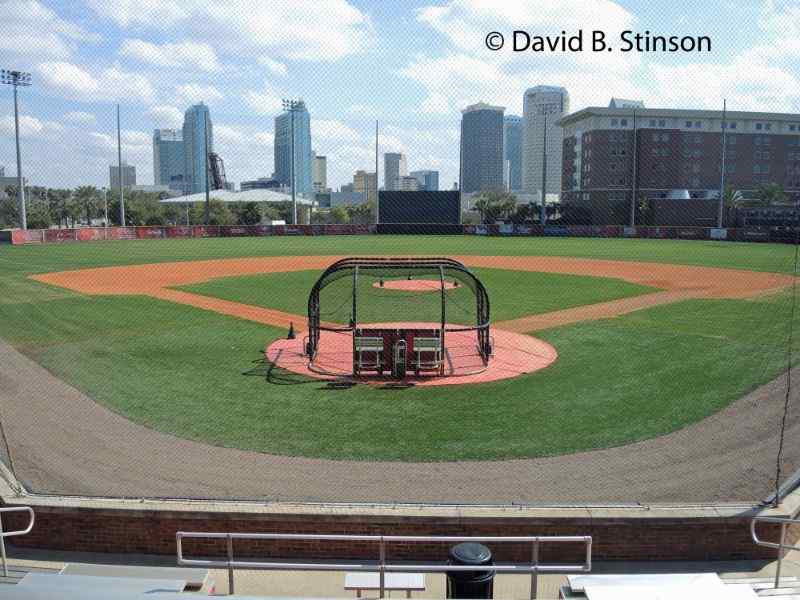
It is fitting that baseball is still played on a portion of the old Florida Fair Grounds, in close proximity to the former site of Plant Field. The University of Tampa has an excellent baseball program, having won the NCAA Division II championship six times in the past 25 years.
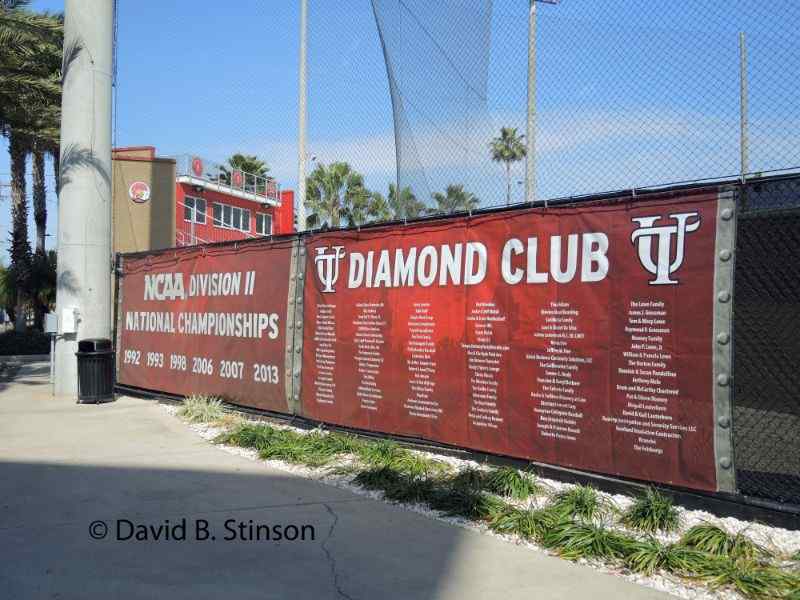
Former University of Tampa standout (and former New York Yankee, Tampa Bay Ray, and St. Louis Cardinal) Tino Martinez is honored with a retired number plaque located above the grandstand.
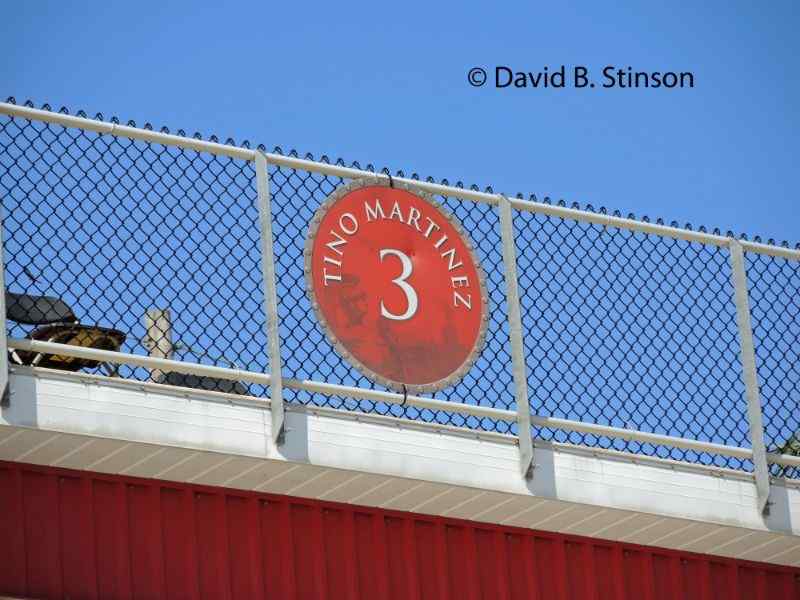
Although Plant Field is now a lost ballpark, the field where major league baseball spring training in Tampa was born, and was held for over 40 years, remains an athletic field. With the placement of the current grandstand at Pepin Stadium on the University of Tampa campus, it is not hard to imagine how Plant Field must have looked during its heyday. For more information about the history of Plant Field (including vintage photographs) see Tampapix.com. If you find yourself in Tampa for spring training, take a detour to the University of Tampa (located just five miles southeast of George Steinbrenner Field) and see for yourself where spring training was first played in Tampa.
Many thanks to the University of Tampa, Special Collections, for their assistance in sharing the history and photographs of Plant Field.
